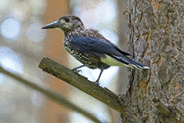

 We all know that many different species of birds plant seeds so that they can eat them later. Some trees depend on the birds to plant their seeds, and some birds depend on just one kind of tree for the seeds they need to survive. A recent study of Swiss stone pine trees in the Carpathian mountains and the Alps has given scientists an understanding of how well this system works, and how it is designed into the DNA of the spotted nutcracker.
We all know that many different species of birds plant seeds so that they can eat them later. Some trees depend on the birds to plant their seeds, and some birds depend on just one kind of tree for the seeds they need to survive. A recent study of Swiss stone pine trees in the Carpathian mountains and the Alps has given scientists an understanding of how well this system works, and how it is designed into the DNA of the spotted nutcracker.
Swiss stone pine trees produce their seeds in August, September, and October. The spotted nutcracker is a bird that feeds on the seeds from the stone pine. In order to survive, the nutcrackers have to store these seed for eight months. Most seeds will sprout well within eight months, especially if there is a spring thaw with rain and warmth.
Researchers from universities in Germany gathered 900 stone pine seeds and randomly cached them in likely storage places — under snow, near shrubs, beneath a tree, etc. They then spent 400 hours watching spotted nutcrackers hide the seeds. What they found was that the nutcrackers universally planted the seeds where germination was very unlikely — places with no moisture, heavy shading, etc. The stone pine tree is a tree with a life expectancy of about 500 years. The tree is totally dependent on the nutcrackers for planting, and the birds are dependent on the tree for food. Since the tree has such a long life, only a few seeds need to germinate. The nutcracker needs to have most of the seeds not germinate to provide a good supply of food.
Constructing a possible evolutionary scenario to explain this symbiotic relationship requires a great deal of faith. Believing that the system was carefully constructed by an intelligence that built the genetic codes of these two organisms together is easy to believe. God has designed the creation in which we live. It is not a function of blind, mechanical processes. Source: Scientific American, March 2015, page 14.
Picture credits:
© Geschaft. Image from BigStock.com.
